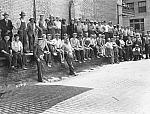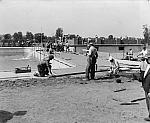
A Pool for the People: Building Richmond Park Pool and Bath House
by Emily Hamstra, U of M graduate student
published: August 6th, 2007
The Great Depression brought great changes to America. The crash of the stock market greatly affected the furniture industry in Grand Rapids. The city, like the rest of the country, was faced with surging rates of unemployment. City Manager, George Welsh, saw first hand that the federal relief program was not meeting the needs of the people of Grand Rapids, and that local relief organizations were running dry. He decided to face the problem at the local level by making major cuts in the city budget in order to establish a localized relief program. (Find more information to your right in Related Items)
Welsh used the available funds to begin the Scrip Labor Project in Grand Rapids which was essentially a work-for-relief program. Instead of money each laborer was paid about fifty cents per hour in scrip coupons which could be used at stores set up by the city. Scrip labor was not unique to Grand Rapids, but the extent to which it was used was unprecedented. The projects included snow removal, Grand River bank cleanups and dredging, demolition of old city buildings, cleaning and salvaging of materials from demolished buildings, the building of the Civic Auditorium, painting City Hall, shoe repair, canning foods, and the building of Richmond Park Pool and Bath House.
In 1929 Welsh proposed to the City Commission that city build a pool on the west side of Grand Rapids using labor paid with scrip. The City Commission approved his idea and allotted a small eighteen thousand dollar budget for the pool to be built at Richmond Park. The limited budget did not mesh with Welsh's big ideas for the proposed pool. He began vetoing the plans he was receiving for the pool, insisting that the pool needed to be larger. To keep him quiet, the frustrated architects drafted Welsh a plan for a 150' X 150' pool as a joke. Putting funding issues aside, Welsh accepted the plan, and excavation began in 1930.
After the project had begun, Welsh learned that to meet state regulations the prospective pool would need a filtration system. Richmond pool, unlike the city's smaller pools, could not be drained and refilled overnight, but would take close to two and a half days to drain and another two to refill. Left with no choice, Welsh motioned the City Commission to okay building an elaborate filtration system for the pool. The commission agreed, but to gain extra funding for the pool more corners had to be cut in the city budget.
Richmond Park Pool was completed and opened in the summer of 1931. The fire department assisted in filling what Welsh called "the 830,000 gallon monster" with water from nearby fire hydrants. But, even with the pool completed, the project was not finished. Welsh was approached with the idea of building a bath house at the pool to provide patrons with shower facilities and locker rooms. Once again, without the adequate funding, Welsh accepted the plan.
The bath house was constructed during the following year, also through the use scrip labor. To help save money and to create more scrip labor jobs, the bricks for the bath house were salvaged from the buildings along the Grand River that had been demolished to make way for the future Civic Auditorium. Huge piles of bricks were cleaned by hand, one at a time.
Richmond Park Pool and Bath House officially opened on July 13, 1932. The Grand Rapids Press gave an estimation of some six thousand west-siders in attendance at the opening ceremonies. The ceremony began with swimming and diving competitions, and was complete with a high school band "perched on top of the filtration plant."
When the competitions were finished, at the sound of a bugle over four hundred children jumped into the pool. It eventually became so crowded that the boys had to clear the pool so the girls could swim; the boys took their turn later. Welsh said, "I got the thrill of [my] life when we saw the overgrown, out-sized monster filled to the brim with happy kids."
Though the pool itself has been rebuilt, the sense of community it's provided to the West Side remains as steady as the seventy- five-year-old bath house. The city commission, mayor, and citizens of Grand Rapids have been fighting for the pool since its humble beginning on the drafting tables in 1929. Since then the pool has hardly passed a season without facing the issue of funding. But thanks to the early vision of a grand pool on the West Side by George Welsh and support of city politicians after him, the Richmond Park Pool and Bath House have provided a wealth of resources for the West Side neighborhood.

Grand Rapids Historical Commission and the Community Media Center present "Glance at the Past". Today, the squeaky clean history of the west side's first public pool.
Bibliography
Items available at the GR History and Special Collections, Grand Rapids Public Library
- Scrip Labor Collection, 1929-1932, #67
- Harms, Richard H. "Paid in Scrip." Michigan History Magazine (January/February 1991): 37-42.
- Welsh, George. "How Richmond Park Pool was Built-When They Said it Couldn't be Done." The Interpreter, 31 January 1974.
- Grand Rapids City Commission. 1960 Grand Rapids: Park Story.
- Ortquist, Richard T. Depression Politics in Michigan, 1929-1933. New York: Garland Pub., 1982.
Books available at the Grand Rapids Public Library
- Mitchell, Ralph A. Standard Catalog of Depression Scrip of the United States: the 1930s including Canada and Mexico. Iola, WI: Krause Publications, 1984.
- Curtis, Paul. Bud, not Buddy. Thorndike, ME: Thorndike Press, 2000. (fiction)









 facebook
facebook
